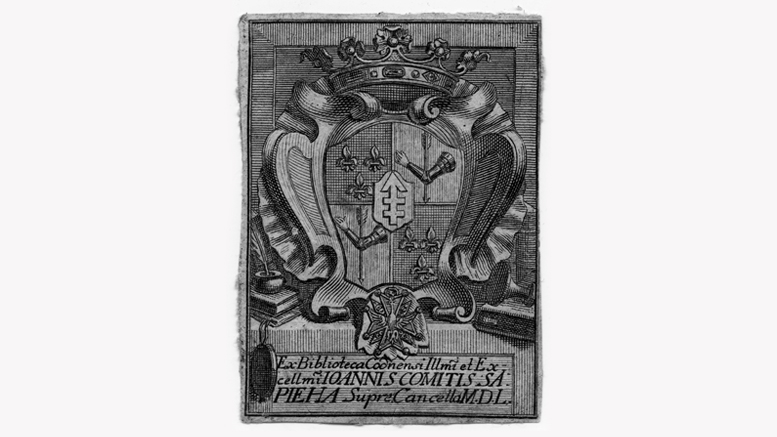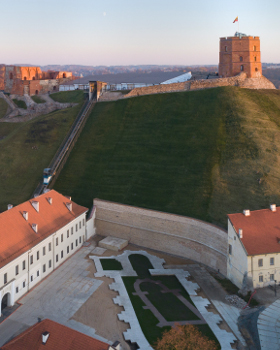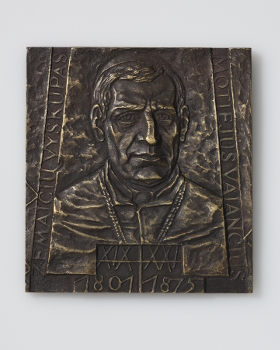
Mikołaj Krzysztof “the Orphan” Radziwiłł (1549–1616)
Engraved by Lucas Kilian. Augsburg, 1604–1616. Copper engraving


Anna Katarzyna Sanguszko Radziwiłłowa (1676–1746), wife of Karol Stanisław Radziwiłł
Engraved by Girsh Leibovich. 1745–1758. Copper engraving


St Casimir
Artist Franciszek Balcewicz. Vilnius, 1749. Copper engraving


Plague in Vilnius in 1710
Engraved by Ignacy Karęga after a drawing by Franciszek Pelikan. Vilnius, 1799. Copper engraving


Grand Duke of Lithuania Vytautas
Józef Ozięblowski’s lithographic printing house. Vilnius, 1841. Lithograph


Grand Duke of Lithuania and King of Poland Jogaila
Józef Ozięblowski’s lithographic printing house. Vilnius, 1841. Lithograph


Vilnius Lower Castle
Artist Karol Raczyński. Maciej Przybylski’s lithographic printing house. Vilnius, 1832. Lithograph


Interior of St Casimir’s Chapel in Vilnius Cathedral
Józef Ozięblowski’s lithographic printing house. Vilnius, 1843. Lithograph


Church of St Peter and St Paul in Vilnius
Józef Ozięblowski’s lithographic printing house. Vilnius, 1834. Lithograph


Aušros Vartų Street
Lithographer Louis Pierre Bichebois. Figures by Victor Adam. Artist Karol Ripiński, after a painting by Marcin Zaleski. From "Album de Wilna" by Jan Kazimierz Wilczyński. Joseph Lemercier’s printing house. Paris, 1846. Chromolithograph


Vilnius Cathedral
Lithographer Izidore Deroy, after a drawing by Vassily Sadovnikov. From "Album de Wilna" by Jan Kazimierz Wilczyński. Joseph Lemercier’s printing house. Paris, 1847. Lithograph


Barbora Radvilaitė
Lithographer François Grenier. After a painting from Nesvizh Castle. From "Album de Wilna" by Jan Kazimierz Wilczyński. Joseph Lemercier’s printing house. Paris, after 1857. Lithograph


Motiejus Valančius
Lithographer Adolphe Lafosse. From "Album de Wilna" by Jan Kazimierz Wilczyński. Joseph Lemercier’s printing house. Paris, circa 1855. Lithograph


Nowogródek
Artist Napoleon Orda. From "The Album of Historical Views of Poland". Maksymilian Fajans’s lithographic printing house. Warsaw, 1878. Lithograph


Kėdainiai
Lithographer Adolphe Lafosse. From "Album de Wilna" by Jan Kazimierz Wilczyński. Joseph Lemercier’s printing house. Paris, circa 1855. Lithograph


Biržai
Lithographer Adolphe Lafosse. From "Album de Wilna" by Jan Kazimierz Wilczyński. Joseph Lemercier’s printing house. Paris, circa 1855. Lithograph


Bookplate. Paweł Ksawery Brzostowski (1739–1827), public figure of the Grand Duchy of Lithuania, priest
Unknown artist. Before 1762. Copper engraving


Bookplate. Jan Fryderyk Sapieha (1680–1752), Grand Chancellor of the Grand Duchy of Lithuania
Engraved by Johann Friedrich Mylius. Circa 1736–1751. Copper engraving


Bookplate. Paulius Galaunė
Artist Paulius Galaunė. 1924. Stroked stereotype

This collection consists of prints made in various techniques. The most valuable items in this collection are examples of early graphic arts: portraits of Lithuanian Grand Dukes and magnates, views of Vilnius and other cities of the Grand Duchy of Lithuania, and images of various saints. Carvings by Lucas Kilian, Girsh Leibovich, and Franciszek Balcewicz should be distinguished. Particularly significant is the collection of 19th century lithographs that marks the beginning of a new era of book illustration and represents the production of lithographic printing houses of Michał Przybylski, Józef Ozemblowski, and Antoni Klukowski that operated in Vilnius. The collections of Jan Kazimierz Wilczyński’s (1806–1885) publications – „The Vilnius Album“ and „The Album of the Vilnius Archaeology Museum“ – are among the largest in Lithuania. A valuable exhibit is the complete „Album of Historical Views of Poland“, made in the lithographic technique after the drawings by Napoleon Orda (1807–1883), which conveys the romantic past of the Grand Duchy of Lithuania in the Romanticist style. A considerable part of the collection consists of works by 20th century artists Jerzy Hoppen, Saulius Ikamas, Vincas Kisarauskas, and Arvydas Stanislavas Každailis. Works by contemporary artists are regularly added to the collection, among them prints from the cycle „Diaries of Death“ by the Lithuanian National Culture and Arts Prize winner Kęstutis Grigaliūnas, works by Viktorija Daniliauskaitė and others.
A separate group in the collection consists of drawings, printed material, and bookplates. The group of bookplates is exceptionally rich. The earliest exhibits are bookplates from the Book of Magnates of the Grand Duchy of Lithuania, which belonged to the collection of the Vilnius Museum of Antiquities. There are a great many bookplates created by 20th century Lithuanian artists. The majority of works are by Vincas Kisarauskas, Gerardas Bagdonavičius, Alfonsas Čepauskas, Viktorija Daniliauskaitė, Vytautas Jakštas, and Antanas Kmieliauskas. The collection includes quite many bookplates by international artists related to Lithuania. In 2005 ethnologist Vacys Milius donated his long-accumulated collection of Lithuanian bookplates to the museum. Artist Valerijonas Vytautas Jucys donated bookplates that were exhibited in Lithuanian republican exhibitions and Vilnius international biennials. The museum’s collection contains more than 21 thousand bookplates.
 Back
Back 




























